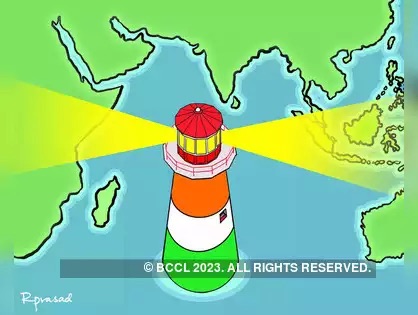The collapse of the Nova Kakhovka Dam in southern Ukraine, under Russian occupation, results in extensive flooding, escalating tensions and allegations of war crimes.

This set of satellite images provided by Maxar Technologies illustrates the Kakhovka Hydroelectric Power Station (left) on June 5, 2024, and the subsequent damage to the same area on June 6. ((Photo by Satellite image 2024 Maxar Technologies / AFP))
On Tuesday, a significant dam and hydroelectric power plant named Nova Kakhovka, situated in the southern region of Ukraine under Russian occupation, experienced a collapse, resulting in a critical emergency characterized by severe flooding.
The incident has sparked heightened tensions, with both sides involved in a blame game. Ukraine has accused Russia of intentionally committing a war crime by deliberately targeting the dam. It is important to note that the Geneva Conventions explicitly prohibit the deliberate targeting of dams during times of armed conflict.
The collapse of the dam has put approximately 42,000 individuals residing in both Russian and Ukrainian-controlled territories along the Dnipro River at risk of flooding. The city of Kherson, located approximately 60 km downstream from the dam, experienced a significant surge in water levels, rising by 3.5 meters on Tuesday.
The ecological impact of the flooding has also been severe, affecting the region’s plant and animal life. Tragically, all 300 animals in the Kazkova Dibrova Zoo, situated on the Russian-held riverbank, perished as a result of the disaster, according to statements made by zoo officials on social media.
The dam held critical importance in supplying water to the Russia-controlled Crimea region, further compounding the repercussions of its collapse. The loss of this vital water source adds additional challenges to an already complex situation.
On Wednesday, Martin Griffiths, the United Nations humanitarian chief, expressed deep concern, stating that the collapse of the dam exacerbates the suffering of those already affected by the Russia-Ukraine conflict. He emphasised the urgent need for ongoing assistance efforts to alleviate the growing hardships faced by the affected population.
It is imperative to swiftly address the immediate humanitarian needs of the impacted individuals and communities. The collapse of the dam further magnifies the difficulties faced by those already affected by the conflict, underscoring the urgent requirement for coordinated and timely aid efforts to provide relief and support to those in need.
Ukrainian President Volodymyr Zelensky and Russian authorities have traded accusations regarding the destruction of a dam near Moscow. Zelensky claimed that Russia had been in control of the dam and the entire Kakhovka HPP (Hydro Power Plant) for over a year. He stated that it would have been physically impossible for the dam to be destroyed from the outside by shelling and alleged that it was the result of Russian occupation and mining.
In contrast, Russia placed the blame on Ukraine, asserting that Kyiv had blown up the dam to hinder the advancing Russian forces. Russian Defense Minister Sergei Shoigu claimed that their forces had halted Ukraine’s counteroffensive, resulting in heavy destruction for Ukrainian soldiers. He further alleged that the decision to demolish the dam was made by Ukraine to slow down the approaching Russian forces.
Neither side has presented concrete evidence to support their claims, and the United States has refrained from taking a definitive stance. Deputy US Ambassador to the UN, Robert Wood, commented that it would be counterproductive for Ukraine to destroy the dam and harm its people.
The Nova Kakhovka dam, situated on the Dnipro River, was positioned between the territories controlled by Russia (left bank) and Ukraine (right bank). Due to the ongoing war in the region, access to international agencies has been restricted, making it challenging to establish the true cause of the dam’s destruction. While there is limited information available, experts suggest that the magnitude of the blast indicates it likely occurred within a confined space using powerful explosives, strategically aimed at the surrounding structure to cause extensive damage.
Conversely, experts also argue that if the explosion had taken place outside the dam, whether from a bomb or missile, only a small portion of the force would have impacted the dam. This would necessitate a significantly larger explosive to produce the observed level of destruction.
Nick Glumac, an engineering professor and explosives expert at the University of Illinois at Urbana-Champaign, explained that warheads have limitations regarding the amount they can carry, which supports the notion that a larger explosive would be required for external detonation. The destruction of the Nova Kakhovka dam has heightened concerns about a potential nuclear incident due to the reliance of the Zaporizhzhia power plant on the upstream Kakhovka reservoir for its cooling systems.
The International Atomic Energy Agency (IAEA), the United Nations’ nuclear watchdog, has stated that the Zaporizhzhia facility, situated further upstream on the reservoir, should have a sufficient water supply from an alternative pond to cool its reactors for “several months.”
As preparations are underway in Kyiv for its anticipated counteroffensive, military analysts suggest that the flooding caused by the dam’s destruction may work in favour of Russia by impeding or limiting Ukraine’s advancements in that particular area of the front line.
In contrast, the Kremlin has accused Ukraine of deliberately diverting attention away from what Moscow claims to be the initiation of a substantial counteroffensive that is proving unsuccessful.












